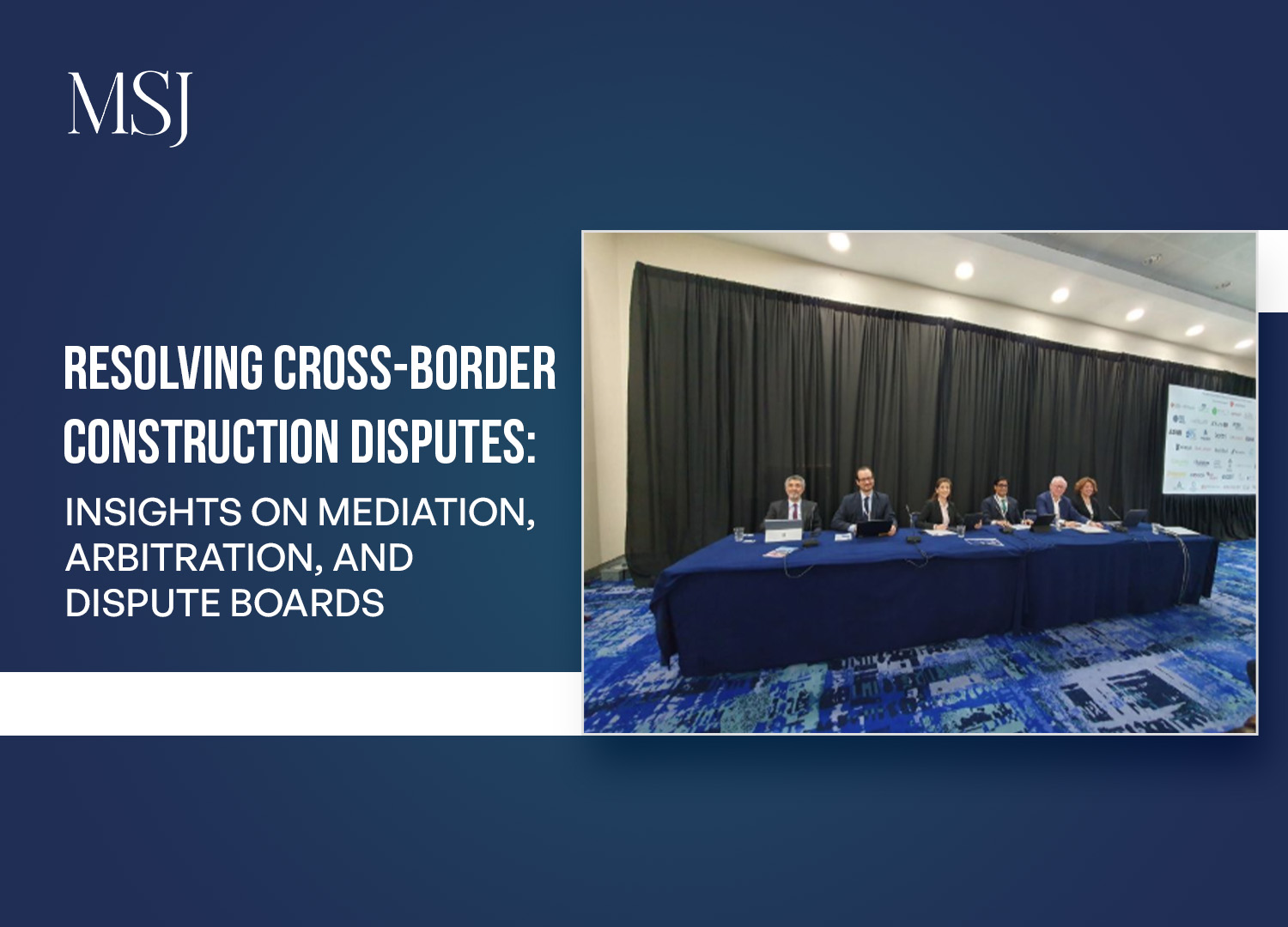AI and ODR in Arbitration: Innovation, Ethics, and the Future of Dispute Resolution
Sheraz has primarily discussed the development of ODR and AI in the arbitration process, which has radically changed the 21st-century interface of legal dispute resolution. The transformation has been driven by worldwide developments in technology, the growing use of the internet, and the increasing demand for effective and accessible systems for dispute resolution. In his presentation, Sheraz stressed the history, current developments, and challenges associated with ODR and AI in arbitration, focusing on their impact on traditional dispute resolution systems, the role of institutions such as the ICC and AAA, and the future possibilities that AI-powered solutions could provide.
The Rise of Arbitration and ODR
Historically, dispute resolution was localised within court systems considered traditional, often within the bounds of geographic and jurisdictional scope. However, towards the end of the 20th century, the advent of the Internet catalysed a change. The Internet was, so to speak, originally used for academic and military workplaces, therefore not having had much use before in commercial employ. With the advent of globalisation, the demand for efficient and accessible means to resolution for cross-border disputes was unprecedented. ODR is an answer to this perennial need of efficiently resolving the increasing number of disputes arising from cross-border commercial transactions. ODR, in which disputes are resolved with the help of a virtual platform without the physical presence of concerned parties, has often been a desirable solution for online businesses where buyers and sellers are situated in different parts of the world.
Sheraz has also discussed how institutional arbitration organisations like ICC and AAA began to grow in importance by formalising and standardising the practices of arbitration itself. They offered a more flexible and efficient alternative to the traditional legal path. While the development of the process took place, the gradual preference for arbitration over litigation came into being because of a greater push by arbitration for speedy closing of disputes and a quest for confidentiality, which was particularly valued in the palate of a globalised economy.
The Emergence of ODR and Blockchain Arbitration
The presentation made by Sheraz elaborated on the increasing complexity of international transactions and how ODR emerged as a very valid option for resolving conflicts. Traditional arbitration methods became slow, expensive, and inadequately suited for the fast-moving nature of global commerce. ODR, using technology, video conferencing, chatrooms, email exchanges, and bespoke online platforms, offered a quicker, less costly way of resolving disputes. With the ability to have the parties settle disputes without requiring an in-person meeting or being physically present in court, ODR has particularly given help in dealing with cross-border disputes by alleviating jurisdictional barriers and providing access to justice irrespective of geography.
The presentation also discussed how blockchain technology introduced an alternate form of arbitration. With the help of decentralised blockchain technology and smart contracts, blockchain arbitration manages the arbitration processes, ensuring that submission, decision, and enforcement remain transparent and tamper-proof. Due to the immutable nature of blockchain, due record maintenance minimises the risk of fraud or manipulation—a major benefit in high-stakes disputes involving financial transactions. Automatic blockchain and smart contracts limit the need for human input post-decision, thus speeding up the enforcement process.
ODR in Courts
With the growth of technology, ODR even began to be welcomed within court systems for more efficient caseload management, which was an integral part of Sheraz's presentation. ODR court programs, allowing litigating parties to resolve disputes via online systems, have been piloted in several jurisdictions. Initial trials dealt with traffic citations, small claims, eviction proceedings, debt collection, and family cases. Court-ODR programs allow the entire process to happen online, in contrast with traditional court systems, simplifying such aspects as e-filing, video hearings, and synchronous or asynchronous mediation. The Covid-19 pandemic fast-tracked the adoption of court-ODR, where virtual hearings and ODR systems became invaluable in maintaining court function while ensuring justice access.
Sheraz pointed out that in countries like Pakistan, the infusion of ODR into the traditional court systems has been slow, but there have been some initiatives. The Sindh High Court took the lead in introducing e-hearings, and only recently did the Supreme Court of Pakistan start live streaming its proceedings. There is great potential for ODR to assist in unclogging the grave backlog of cases that exist within the court systems of Pakistan and, in the process, significantly lowering the costs of traditional litigation, rendering the process faster and opening it up to a wider public base.
Challenges of Implementing ODR and AI
Sheraz also commented that, while ODR presents many benefits in its execution, it faces a lot of difficulties. These include technological issues such as the reliability of software, data protection, and technology access. To maintain users' trust, it is imperative that the ODR platforms are secure and able to work with sensitive materials. Apart from that, the digital divide provides a significant challenge to the widespread use of ODR. Areas with weak technological infrastructure or while dealing with economically disaffected people might not be able to use the digital route for conflict resolution with ease.
Sheraz also spoke of certain regulatory and legal challenges afflicting ODR. ODR platforms must comply with the existing legal frameworks, and that compliance can vary quite starkly across different jurisdictions. Besides, when a dispute involves parties from different jurisdictions, jurisdictional issues surface, and it is paramount for ODR's decisions to be enforceable across jurisdictions for them to be effective.
Cultural resistance was another challenge discussed. Many legal community members and disputants are used to conventional alternatives to resolving disputes and, therefore, might be hesitant to embrace digital alternatives. The building of trust in these digital systems is crucial in adopting them widely. Transparency, consistency, and fairness are factors guiding the users in building their confidence.
The Role of AI in Arbitration
Coming now to the third phase, that of artificial intelligence in the sphere of arbitration, Sheraz explains how increasingly AI is being harnessed for various aspects of arbitration. AI tools assist with duties such as document review, legal research, and data analysis. These tools have the capability of automating mundane tasks, taking less time, and lowering the cost of arbitration, making it more efficient. But AI has its own limitations; while AI can provide analysis on data and identify a pattern based on it, it cannot think critically, solve problems or comprehend contextual issues such as human arbitrators do.
The use of AI in arbitration raises critical ethical questions. The SVAMC AI Guidelines outline the responsibilities of arbitration participants using AI, with due concern on confidentiality, notification, and decision-making. The confidentiality of the AI tools used should always be ensured, and sensitive information should be protected against any unauthorised access. Information about the use of AI may not always need to be disclosed; however, when the situation arises in particular cases, disclosures should be made for the sake of fairness and transparency. Another major anthropocentric principle is non-delegation, which holds that arbitrators generally should not delegate the authority to make decisions to AI tools. The human aspect must be protected within the process of arbitration to uphold both fairness and impartiality.
The Future of AI in Arbitration
According to Sheraz's analysis, AI is likely to play a bigger role in arbitration future years than it has done so far, especially in predicting outcomes and getting assistance to bring the parties into a position where they are aware of the possibilities before decisions are made. LexMachina and Solomonic tools rely on historical data to provide insights that enable parties and counsel to make more informed decisions on any possible outcomes for a particular case. There are still big challenges left, such as fears of overreliance on AI and its inability to take into account the specific surroundings and circumstances of any one case. Also, in this day and age, transparency and accuracy in AI models are highly important, so that no bias might get perpetuated and no unfair decision rendered.
Concluding the insightful presentation, Sheraz highlighted some of the advantages and disadvantages while proceeding with regulation, lest there should be unfairness or misconceivance. In a fast-developing world, AI may represent a huge enhancement by removing mundane chores and providing data-cut analyses, yet it must be cautiously regulated. AI must support human judgement, not replace it in arbitration. With the ongoing evolution of AI, it will likely still play an increased role in the resolution of legal disputes; however, one must keep the cons and ethical aspects clearly defined so that fairness, transparency, and human oversight remain properly hardwired within such decisions.







